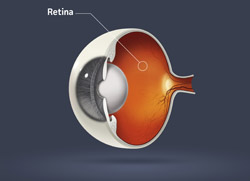Towards understanding of retinal degeneration
Photoreceptors are the light-sensitive neurons in the eye that enable vision. Their degeneration underlies age-related macular degeneration (AMD), currently affecting over 20 million Europeans. The project 'Role of TAM signalling in retinal homeostasis' (TAM IN AMD) aimed to compare photoreceptor function during health and degeneration. Specifically, the aim of the project was to understand the functioning of the tyrosine kinase receptors of the TAM family in the retina. Signalling through TAM receptors (Tyro3, Axl, and Mer) is essential for maintaining a functional retina. The mechanistic aspects of TAM signalling, involving TAM ligands (PROS1 and GAS6) are mostly unclear. The project detected that retinal expression of Gas6 exceeded that of PROS1 20 times, suggesting its greater importance, but results were surprising, showing that PROS1 is critical to retinal health. The scientists studied the contribution of PROS1 to retinal health using genetically engineered mice. While deletion of PROS1 or Gas6 alone was not sufficient to cause retinal degeneration, deletion of both Gas6 and PROS1 resulted in severe retinal degeneration. This effect was similar to one caused by deletion of the TAM receptor Mer. A first, the results indicate that PROS1 is a functional ligand for TAM receptors in vivo, crucial for photoreceptor viability and retinal health. Finally, the project evaluated the potential use of PROS1 levels in the eye as a biomarker for retinal degenerative disease. A pilot study tested the aqueous humour samples from patients with retinal degenerative disease and healthy individuals. The results indicated a high level of PROS1 in all healthy individuals, while the majority of diseased patients had low levels of PROS1. This suggests that low levels of PROS1correlate with retinal degenerative disease. A broader study involving more subjects is needed to confirm this hypothesis. Understanding the causes and mechanisms of retinal degenerative diseases help in developing new diagnostics and treatments.







